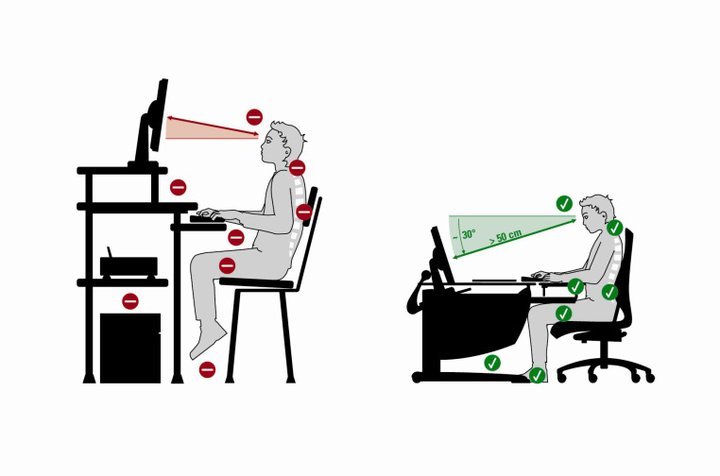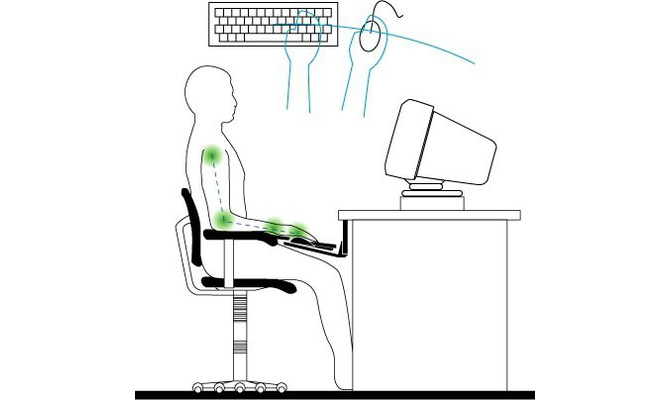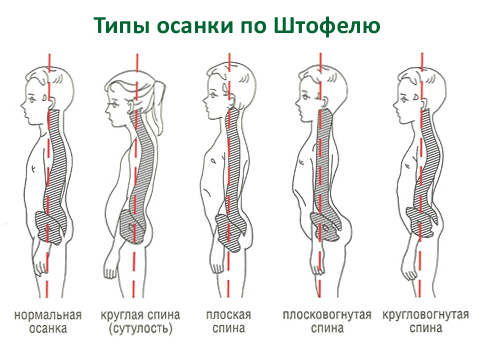Organization of the workplace from a position of back health (and not only)
After my previous article on posture correctors, I was asked in the comments to state my view on the equipment of the workplace at the computer from the position of spinal health and to minimize the effect of the posture on the occurrence of pain in various parts of the back.
Before starting to systematize knowledge on this issue myself, I decided to look at what is written on the Internet on this issue. And with surprise I realized that until the end of sensible advice almost nowhere to be found. There are a lot of articles, the right things are often said in them, but I didn’t find them all right in the same place. In order to save time, I decided to write it myself.
So, here it is right away - a couple of pictures that seem to demonstrate "how to properly sit at the computer."


So - it’s not necessary to sit like that. Even as marked in green.
I will try to describe how it is worth organizing your workplace.
Chair. The chair should be comfortable. It is worth lining a few centimeters thick on the seat (2/3 of its rear), while making sure that the edge of the chair is also soft. Again, the general essence of what we want to achieve with this: the edge of the stool should not press on the thigh and pinch the vessels and nerves, the angle between the trunk and thigh along the front surface should be 95 or more degrees, the angle between the hip and knee along the back surface should be 95 degrees or more. It is better in both cases a little more than less - this will avoid squeezing the vessels in the inguinal and popliteal areas.
Right here, according to the position of the feet - they should not hang in the air, shins should not be bent under a chair. If the chair is too high - it is best to buy / make a stand (well, or put 1-2 packs of office paper or something else). That is, the feet should be fully surface on the floor / stand. If the chair is too low, and the feet are only on the floor with their knees up and the angle between the body diminished, you should consider how to adjust it.
The back of the chair should be up to the middle of the shoulder blades or higher (again, in the literature I have come across the phrase “the back should cover the shoulder blade by 3-5 centimeters”). The angle between the seat and the back of the chair should be approximately 110 degrees for work (130 degrees for rest).
According to the position of the countertop - if you write a lot, then it should be inclined.
Under the lower back you need a pillow or selection. Asked a question about the magnitude of this selection, I will dwell a little more.
In one of the most commonly used Staffel classifications (or Stofel, depending on the translation), 5 types of posture are distinguished:

In all types of posture from this classification, the severity of lumbar lordosis varies. Therefore, here it is important to understand exactly the essence again: the lower back should not “sag” or oversize. That is, sitting exactly on the chair, you should feel support in the lumbar. Not pressure, not a feeling of "emptiness", but support. In the case of a small selection, the lordosis in the lower back will be smoothed, the muscles will strain. With an excessively large selection, discomfort and again muscle tension will be felt.
Forearms.Ideally, the chair on which you are sitting should have armrests that vary in height. In one book, I met the figure "the armrests should be 23 cm (9 inches) from the surface of the seat" - a direct quote. I understand and respect the experience of the authors of the book, but I would not be so categorical. The general essence is this: the forearms should lie freely and calmly on the armrests. If the elbows "fail" - there is a stretching and subsequent compensatory tension of the shoulders (in particular, the upper portions of the trapezius muscle). If the forearms and elbows are too high, then the trapezius muscle is constantly tensed. Usually the height is selected individually, it is approximately possible to navigate to the navel level (in a calm state at this level are the elbows of the "average" person).
From the same recommendations, the logical position of the hands behind the keyboard follows: there should not be strong flexion and extension in the wrist joints, otherwise everything will lead to compression neuropathies (“tunnel syndromes”). In the same way, the forearms should not be squashed by the edge of the table or the edge of the armrest. Therefore, it is most convenient if the height of the table is matched to the height of the armrest when the keyboard is on the tabletop, or to the level of the sliding shelf with the keyboard, and the forearm lying on the arm rests calmly and freely on the surface of the table / shelf.
The position of the head should be adjusted only if all of the above is observed.In order to maximally avoid the head moving forward (and, as a result, the extension in the cervical region), the computer monitor should be placed at eye level. I specially checked it - you can cover almost the entire height of the average monitor with 19 inches with your eyes without changing the position of the head (or changing within 5 degrees). Therefore, we focus that for people with existing complaints about problems with the neck, the middle of the monitor is located at the level of the gaze of an evenly sitting person. If there are no problems with the neck and you equip your workplace exclusively from a prophylactic position, then the top edge of the monitor is at the level of sight.
The second monitor, working literature and documentation should be placed on the side of the leading eye (how to determine - for example, we read about the Rosenbach test, it takes no more than a minute). On the same side, it is advisable to put a chair for visitors.
Also, I recommend that all my patients get up every 30-40 minutes, walk for a couple of minutes (activate the venous outflow from the lower extremities), move your shoulders (circular movements in the shoulders back and forth - stretch the muscles of the upper shoulder girdle), sit down 4-5 times ( improve blood flow in the muscles of the pelvis).
Regarding special chairs, standing work - try. But I would recommend that you first try to properly organize the workplace and the work / rest regime. I would not recommend working standing up, since flat feet in its various manifestations are practically the scourge of the modern world (we stopped walking barefoot or on soft soles over uneven surfaces). And instability of the muscles of the feet in the same way leads to problems of the spine. Well, the venous outflow from the lower extremities also works due to the active work of the leg muscles.
Do not be ill!
UPD:
Thanks to Meklon for eye health information:
Before starting to systematize knowledge on this issue myself, I decided to look at what is written on the Internet on this issue. And with surprise I realized that until the end of sensible advice almost nowhere to be found. There are a lot of articles, the right things are often said in them, but I didn’t find them all right in the same place. In order to save time, I decided to write it myself.
So, here it is right away - a couple of pictures that seem to demonstrate "how to properly sit at the computer."


So - it’s not necessary to sit like that. Even as marked in green.
I will try to describe how it is worth organizing your workplace.
Chair. The chair should be comfortable. It is worth lining a few centimeters thick on the seat (2/3 of its rear), while making sure that the edge of the chair is also soft. Again, the general essence of what we want to achieve with this: the edge of the stool should not press on the thigh and pinch the vessels and nerves, the angle between the trunk and thigh along the front surface should be 95 or more degrees, the angle between the hip and knee along the back surface should be 95 degrees or more. It is better in both cases a little more than less - this will avoid squeezing the vessels in the inguinal and popliteal areas.
Right here, according to the position of the feet - they should not hang in the air, shins should not be bent under a chair. If the chair is too high - it is best to buy / make a stand (well, or put 1-2 packs of office paper or something else). That is, the feet should be fully surface on the floor / stand. If the chair is too low, and the feet are only on the floor with their knees up and the angle between the body diminished, you should consider how to adjust it.
The back of the chair should be up to the middle of the shoulder blades or higher (again, in the literature I have come across the phrase “the back should cover the shoulder blade by 3-5 centimeters”). The angle between the seat and the back of the chair should be approximately 110 degrees for work (130 degrees for rest).
According to the position of the countertop - if you write a lot, then it should be inclined.
Under the lower back you need a pillow or selection. Asked a question about the magnitude of this selection, I will dwell a little more.
In one of the most commonly used Staffel classifications (or Stofel, depending on the translation), 5 types of posture are distinguished:

In all types of posture from this classification, the severity of lumbar lordosis varies. Therefore, here it is important to understand exactly the essence again: the lower back should not “sag” or oversize. That is, sitting exactly on the chair, you should feel support in the lumbar. Not pressure, not a feeling of "emptiness", but support. In the case of a small selection, the lordosis in the lower back will be smoothed, the muscles will strain. With an excessively large selection, discomfort and again muscle tension will be felt.
Forearms.Ideally, the chair on which you are sitting should have armrests that vary in height. In one book, I met the figure "the armrests should be 23 cm (9 inches) from the surface of the seat" - a direct quote. I understand and respect the experience of the authors of the book, but I would not be so categorical. The general essence is this: the forearms should lie freely and calmly on the armrests. If the elbows "fail" - there is a stretching and subsequent compensatory tension of the shoulders (in particular, the upper portions of the trapezius muscle). If the forearms and elbows are too high, then the trapezius muscle is constantly tensed. Usually the height is selected individually, it is approximately possible to navigate to the navel level (in a calm state at this level are the elbows of the "average" person).
From the same recommendations, the logical position of the hands behind the keyboard follows: there should not be strong flexion and extension in the wrist joints, otherwise everything will lead to compression neuropathies (“tunnel syndromes”). In the same way, the forearms should not be squashed by the edge of the table or the edge of the armrest. Therefore, it is most convenient if the height of the table is matched to the height of the armrest when the keyboard is on the tabletop, or to the level of the sliding shelf with the keyboard, and the forearm lying on the arm rests calmly and freely on the surface of the table / shelf.
The position of the head should be adjusted only if all of the above is observed.In order to maximally avoid the head moving forward (and, as a result, the extension in the cervical region), the computer monitor should be placed at eye level. I specially checked it - you can cover almost the entire height of the average monitor with 19 inches with your eyes without changing the position of the head (or changing within 5 degrees). Therefore, we focus that for people with existing complaints about problems with the neck, the middle of the monitor is located at the level of the gaze of an evenly sitting person. If there are no problems with the neck and you equip your workplace exclusively from a prophylactic position, then the top edge of the monitor is at the level of sight.
The second monitor, working literature and documentation should be placed on the side of the leading eye (how to determine - for example, we read about the Rosenbach test, it takes no more than a minute). On the same side, it is advisable to put a chair for visitors.
Also, I recommend that all my patients get up every 30-40 minutes, walk for a couple of minutes (activate the venous outflow from the lower extremities), move your shoulders (circular movements in the shoulders back and forth - stretch the muscles of the upper shoulder girdle), sit down 4-5 times ( improve blood flow in the muscles of the pelvis).
Regarding special chairs, standing work - try. But I would recommend that you first try to properly organize the workplace and the work / rest regime. I would not recommend working standing up, since flat feet in its various manifestations are practically the scourge of the modern world (we stopped walking barefoot or on soft soles over uneven surfaces). And instability of the muscles of the feet in the same way leads to problems of the spine. Well, the venous outflow from the lower extremities also works due to the active work of the leg muscles.
Do not be ill!
UPD:
Thanks to Meklon for eye health information:
- Limit the duration of work in general
- Breaks every hour and a half, shift focus from close range into the distance
- Exclude bright point sources of light in the field of view
- Eliminate bright glare from such sources in the field of view
- To minimize the brightness differences in the working field of view, including not working in the dark without highlighting the background (high differences)
